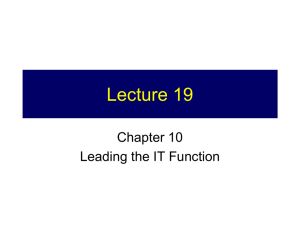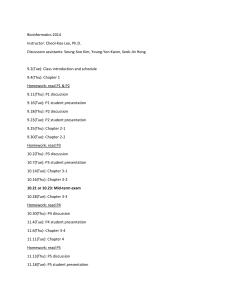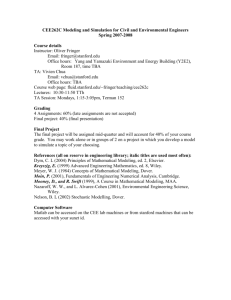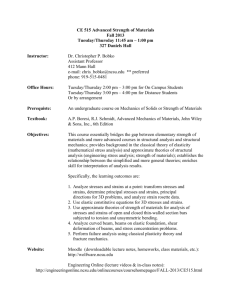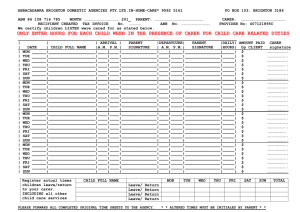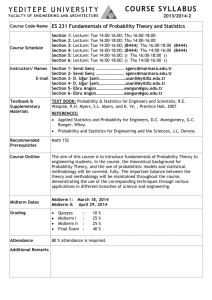MKTG 493 - College of Business | SIU
advertisement
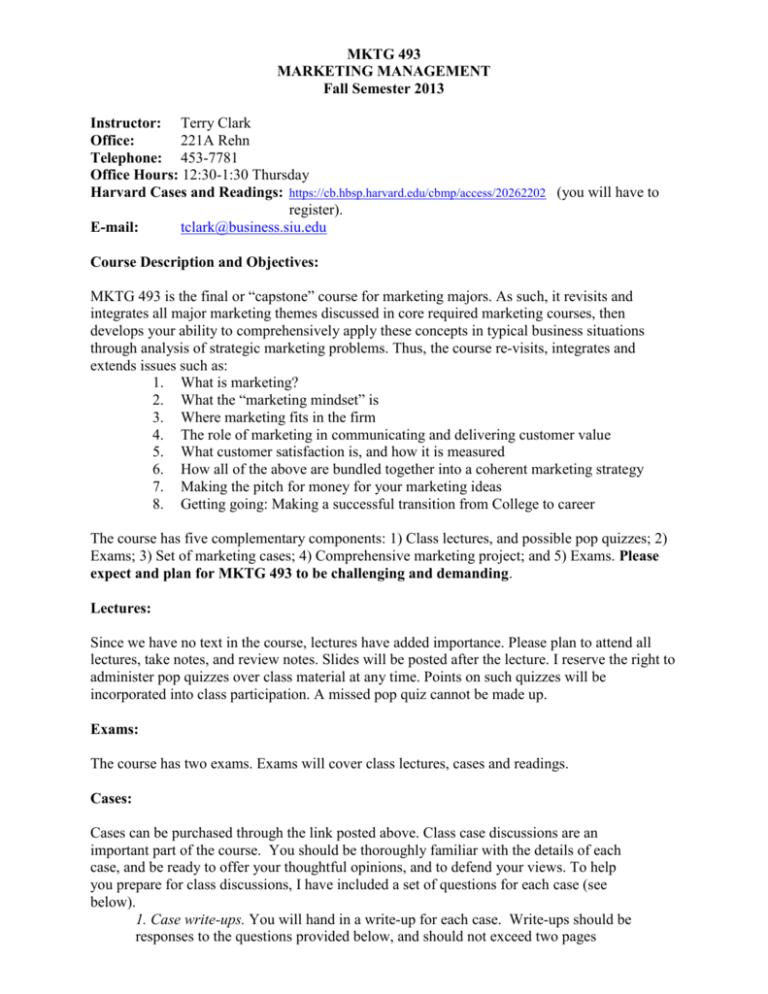
MKTG 493 MARKETING MANAGEMENT Fall Semester 2013 Instructor: Terry Clark Office: 221A Rehn Telephone: 453-7781 Office Hours: 12:30-1:30 Thursday Harvard Cases and Readings: https://cb.hbsp.harvard.edu/cbmp/access/20262202 (you will have to register). E-mail: tclark@business.siu.edu Course Description and Objectives: MKTG 493 is the final or “capstone” course for marketing majors. As such, it revisits and integrates all major marketing themes discussed in core required marketing courses, then develops your ability to comprehensively apply these concepts in typical business situations through analysis of strategic marketing problems. Thus, the course re-visits, integrates and extends issues such as: 1. What is marketing? 2. What the “marketing mindset” is 3. Where marketing fits in the firm 4. The role of marketing in communicating and delivering customer value 5. What customer satisfaction is, and how it is measured 6. How all of the above are bundled together into a coherent marketing strategy 7. Making the pitch for money for your marketing ideas 8. Getting going: Making a successful transition from College to career The course has five complementary components: 1) Class lectures, and possible pop quizzes; 2) Exams; 3) Set of marketing cases; 4) Comprehensive marketing project; and 5) Exams. Please expect and plan for MKTG 493 to be challenging and demanding. Lectures: Since we have no text in the course, lectures have added importance. Please plan to attend all lectures, take notes, and review notes. Slides will be posted after the lecture. I reserve the right to administer pop quizzes over class material at any time. Points on such quizzes will be incorporated into class participation. A missed pop quiz cannot be made up. Exams: The course has two exams. Exams will cover class lectures, cases and readings. Cases: Cases can be purchased through the link posted above. Class case discussions are an important part of the course. You should be thoroughly familiar with the details of each case, and be ready to offer your thoughtful opinions, and to defend your views. To help you prepare for class discussions, I have included a set of questions for each case (see below). 1. Case write-ups. You will hand in a write-up for each case. Write-ups should be responses to the questions provided below, and should not exceed two pages maximum. Case write-ups will be collected immediately after we finish class discussion for that case. Late submissions will not be accepted. 2. Case discussion. You will prepare for all case discussions. This means at a minimum, reading the case, and answering the questions (see below), so that you can talk intelligently about the materials. Project: In teams of 3-5, you will develop a full-blown marketing plan. The plan may be for a new product, a start-up company, an existing nationally branded consumer packaged good, repositioning a product, increasing demand, etc. The project has three related parts: 1) a “marketing plan” document (as outlined below); 2) a set of “process requirements” (as described below); and 3) a class presentation. During your class presentation, I take on the role of CFO/Venture Capitalist/bank loan officer. In other words, you will be making a pitch to me for the marketing budget requested. Below is an outline of a typical Marketing Plan. Tailor it as needed to fit your situation. Ask me if in doubt. I. Executive Summary A one-page (max) non-technical brief of the entire plan, including a description of the product or service, target market, marketing objectives, differential advantage, required investment, and anticipated sales and profits. II. Situation Analysis A basic qualitative/quantitative description of the pertinent factors related to the situation, including: Industry overview; Competitors, their products, target markets and segmentation; Demand trends; Social and cultural factors; Demographics; Economic and business conditions; State of technology; Political issues; Laws and regulations, pending legislation, Special interest groups, etc. (not all parts of this will be appropriate for all plans—use common sense in determining what is important in your situation) III. Marketing Strategy a. The opportunity explained—what is it? Why is it an opportunity? What specifically are you trying to achieve? (revenues? market share? Reposition? new target market?, etc.), including: an explanation of business model, segmentation, target market, competitive advantage, how revenue will be generated. b. Detailed account and justification of segmentation scheme used, target (s) market selected and positioning. c. Detailed account and justification of the marketing mix chosen. d. Detailed account and justification of media plan (budget, choice of media (be specific—including costs, reach, frequency, etc.) IV. Implementation and Control a. An account of all major costs (fixed and variable) associated with your project b. Appropriate financial analysis (breakeven, payback, etc) c. Pro-forma cash flow projections for a three-year period. d. An assessment of the limitations and risks of the project Summary Appendices—all relevant supporting and reference (citations) materials V. VI. Here are the Process Requirements for the project: First group meeting with me to clear your topic, no later than September 12th. At this meeting, you will make a 30-second pitch of your idea to me (please practice!), and turn in a one page briefing document outlining what you propose to do. The purpose of the meeting is for you to convince me that you have a serious and interesting topic. Also at this meeting, you will provide me with a list of times, dates and places for your regular group meetings throughout the semester. From time to time, I may drop in on your group meetings. A progress report based on the above outline by September 26th. The purpose of the progress report is for you to demonstrate to me that the group is focused and making tangible progress. The progress report should spell out what research/analysis has been done, what remains to be done, who in the group is do it, and what the deadlines are for doing it. This report will help me keep track of who is responsible for what. I will provide feedback on this report. Second group meeting, in my office, no later than October 10th. At this meeting, you should deliver me a revision and update of your progress report. Be prepared to discuss and defend in detail what you have done thus far. Problems with group members who do not attend group meetings, and/or do not contribute and/or pull their weight should be brought to my attention at this meeting. Third group meeting may, or may not be needed. If it is needed, it should occur no later than November 14th. The purpose of this meeting is for you to go over the preliminary quantitative analysis sales projections, BE analysis, costs, etc.) of your Marketing Plan with me. 1. 2. 3. 4. Of course, groups may schedule meetings with me at other times as the need arises. Attendance: I have a strict attendance policy. Attendance is taken each scheduled class period. Except for legitimate University approved absences, you are only allowed 1 absence without penalty. After that, each absence will lower your total possible participation grade by 20%. Attendance is taken 5 minutes after class begins. Grading Case Write-ups (12 x 2.5 points) Project: Points 30 30 (Process 30%) (Marketing Plan 40%) (Presentation 30%) Participation (attendance + quizzes) Exams (2x10) Total 20 20 100 Tentative Course Schedule: Date Aug 20 Aug 22 Aug 27 Aug 29 Sep 3 Sep 5 Sep 10 Sep 12 Sep 17 Sep 19 Sep 24 Sep 26 Day Topic Cases/Readings Tue Intro to course Thu The Marketing Plan Tue (re)Discovering Marketing Stainmaster Thu Open/Catch-up/Project Day Tue (re)Discovering Marketing Thu Customer Satisfaction & Starbucks: Delivering Retention Customer Service Tue Customer Satisfaction & Retention Thu Open/Catch-up/Project Day Tue Competition, Business Models XM Satellite Radio (A) and Marketing Thu Competitor & Customer Lestra Intelligence Tue Open/Catch-up/Project Day Thu What Makes Customers Tick? XYLYS Oct 10 Tue Marketing Math Hohner Thu Open/Catch-up/Project Day Tue Marketing Strategy/ Marketing Product Team Cialis Mix Thu Oct 15 Oct 17 Oct 22 Oct 24 Oct 29 Oct 31 Nov 5 Nov 7 Nov 12 Nov 14 Tue Thu Tue Thu Tue Thu Tue Thu Tue Thu Nov 19 Nov 21 Nov 26 Nov 28 Dec 3 Dec 5 Dec 9-13 Tue Thu Tue Thu Tue Thu Oct 1 Oct 3 Oct 8 Events/Deadlines Groups formed Project Meeting #1 Deadline Project Progress Report Due Exam #1/Project Meeting #2 Deadline Fall Break Guest Speaker Drew Stoker--Boeing Open/Catch-up/Project Day Product/Product Positioning Clean Edge Razor Prototyping BMW: The 7-Series Pricing Cumberland Metals Open/Catch-up/Project Day Branding Marketing Communication Lowe’s Companies Inc. Multi-Market Competition Cat Fight in the Pet Project Meeting # 3 (if Food Industry needed) Deadline Open/Catch-up/Project Day You, Your Life, Your Career Open/Catch-up/Project Day Thanksgiving Presentations Presentations Final Exams Case Questions: BMW: Describe BMW’s competitive environment. What problems are they having? What is their approach to product development? Why do they prototype? Cat Fight in the Pet Food Industry: What is the nature of competition in the pet food industry? Construct a table showing market shares by product category for each firm. Who competes with whom where? Which are the most profitable segments? Discuss the implications. Cumberland Metal Industries: Engineering Products Division. What is the market potential for curled metal pads? Calculate and justify a price for the pads. Clean Edge Razor: Describe the non disposable razor category. How is it segmented? What are the strategic life-cycle challenges for Paramount’s products? What changes are occurring? Assess Paramount’s competitive position. Discuss the positioning options for Edge. Which do you recommend? Why? Hohner GmbH & Co. KG: Describe the harmonica market. Answer assignment questions in the case. Lestra Design: What went wrong for Lestra Design? Who’s fault was it, Lestra’s or the Japanese? What marketing research did they do? What marketing research should the have done? Lowe’s: What problems does Lowe’s face deploying the NGIS? What factors influence customers to pursue a kitchen remodel project? Describe the buying cycle. Identify “pain points” in the cycle. How did customer experience mapping help them? Evaluate and make recommendations on their marketing communication plan, Product Team Cialis: How is the ED market segmented? Which should Cialis target? How is Viagra positioned? Fully discuss a marketing to accompany Cialis’s launch. Stainmaster: Describe the carpet industry before and after the introduction of Stainmaster. Explain what happened. Starbucks: Delivering Customer Service: Why was Starbucks so successful in the early 1990s? Compare the Starbucks of 1992 with the Starbucks of 2002. Why have Starbuck’s customer satisfaction scores declined? Describe the ideal Starbuck’s customer. Should Starbucks make the $40 million investment in labor? Why? Why not XM Satellite Radio (A) Describe the radio market. What value does XM deliver over and above its competition? Describe and evaluate the two business models XM radio is contemplating. XYLYS: Describe and discuss the purchase and use patterns of luxury watch users/non-users. Evaluate the responses to the study. Emergency Procedures Southern Illinois University Carbondale is committed to providing a safe and healthy environment for study and work. Because some health and safety circumstances are beyond our control, we ask that you become familiar with the SIUC Emergency Response Plan and Building Emergency Response Team (BERT) program. Emergency response information is available on posters in buildings on campus, available on the BERT’s website at www.bert.siu.edu, Department of Public Safety’s website www.dps.siu.edu (disaster drop down) and in the Emergency Response Guidelines pamphlet. Know how to respond to each type of emergency. Instructors will provide guidance and direction to students in the classroom in the event of an emergency affecting your location. It is important that you follow these instructions and stay with your instructor during an evacuation or sheltering emergency. The Building Emergency Response Team will provide assistance to your instructor in evacuating the building or sheltering within the facility.

